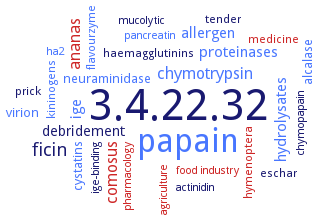3.4.22.32: Stem bromelain
This is an abbreviated version!
For detailed information about Stem bromelain, go to the full flat file.

Word Map on EC 3.4.22.32 
-
3.4.22.32
-
papain
-
ficin
-
comosus
-
chymotrypsin
-
ananas
-
hydrolysates
-
allergen
-
proteinases
-
ige
-
debridement
-
neuraminidase
-
alcalase
-
cystatins
-
virion
-
hymenoptera
-
flavourzyme
-
medicine
-
kininogens
-
prick
-
eschar
-
tender
-
haemagglutinins
-
food industry
-
actinidin
-
ha2
-
agriculture
-
chymopapain
-
mucolytic
-
pharmacology
-
pancreatin
-
ige-binding
- 3.4.22.32
- papain
- ficin
- comosus
- chymotrypsin
- ananas
- hydrolysates
- allergen
- proteinases
- ige
-
debridement
- neuraminidase
- alcalase
- cystatins
- virion
- hymenoptera
- flavourzyme
- medicine
- kininogens
-
prick
-
eschar
-
tender
-
haemagglutinins
- food industry
- actinidin
- ha2
- agriculture
- chymopapain
-
mucolytic
- pharmacology
- pancreatin
-
ige-binding
Reaction
broad specificity for cleavage of proteins, but strong preference for Z-Arg-Arg-/-NHMec amongst small molecule substrates =
Synonyms
acidic bromelain stem proteinase, ACMD2_17643, BRM, Bromelain, Bromelain, stem, EC 3.4.22.4, EC 3.4.4.24, Pineapple stem bromelain, SBA, Sbm, stem bromelain
ECTree
Advanced search results
Inhibitors
Inhibitors on EC 3.4.22.32 - Stem bromelain
Please wait a moment until all data is loaded. This message will disappear when all data is loaded.
Dextran
dextran 70 kDa, for dextran, the crowding effect clearly depends on its molecular weight
L-3-carboxy-2,3-trans-epoxypropionylleucylamido(4-guanidino)butane
-
irreversible
sucrose
-
bromelain in the presence of 1 M sucrose is destabilized under thermal stress, the average melting temperature decrease by 5°C, additionally the enzyme is inactivated faster at 60°C
trans-epoxysuccinyl-L-leucylamido-(4-guanidino)butane
-
i.e. E-64, slow inactivation
trehalose
-
bromelain in the presence of 1 M trehalose is destabilized under thermal stress, the average melting temperature decrease by 7°C, additionally the enzyme is inactivated faster at 60°C
-
competitive inhibition, several isoforms of the native double-chain protein, inhibition mechanism, structure-function relationship, structure modeling of inhibitor protein, bromelain inhibitor VI: PDB 1Bl6
-
Ananas comosus bromelain inhibitor
-
purified from stem, several isoforms of the native inhibitor protein consisting of multiple light and heavy chains, overview, 3D-structure model
-
-
SDS acts as a partial non-competitive inhibitor, 97% inhibition at 100 mM, detailed interaction study and inhibition mechanism, bromelain is partly resistant to SDS binding and denaturation, overview. SDS at submicellar level, below 5 mM, causes conformation change of bromelain leading to a stable entity
SDS
-
for native bromelain, SDS at 4 and 5 mg/ml causes a significant inhibition of 57% and 61%, respectively
-
scarcely inhibited by chicken cystatin (amino acid sequence and implications for weak binding of cystatin)
-
additional information
-
scarcely inhibited by chicken cystatin (amino acid sequence and implications for weak binding of cystatin)
-
additional information
-
scarcely inhibited by chicken cystatin (amino acid sequence and implications for weak binding of cystatin)
-
additional information
-
scarcely inhibited by chicken cystatin (amino acid sequence and implications for weak binding of cystatin)
-
additional information
-
reversible inactivation of the protease in 10 mM Na-phosphate, pH 7.5 containing 5 mM of Na-tetrathionate, during purification, reactivation by 8 mM of DTT and 4 mM of EDTA in the same buffer at 25°C
-
additional information
-
gallic tannins or ellagic tannins show no inhibitory activity
-
additional information
-
grape skin and seed tannins exert uncompetitive inhibition
-
additional information
crowders, such as dextran (D70) and polyethylene glycol (P12 and P20), destablize and deactivate native bromelain, absorption spectra in phosphate buffer, overview. PEGs tend to have different effects on different proteins depending upon the chemical nature of proteins, while for dextran, the crowding effect clearly depends on its molecular weight. PEG does not seem to follow the size-dependent crowding effect as in the case of dextran
-
additional information
stability of bromelain in the presence of EDTA and sodium benzoate
-
additional information
-
stability of bromelain in the presence of EDTA and sodium benzoate
-
additional information
the imidazolium-based ionic liquids, 1-butyl-3-methylimidazolium chloride, 1-butyl-3-methylimidazolium bromide, and 1-butyl-3-methylimidazolium iodide, act as destabilizers on stem bromelain, analysis using UV-visible spectroscopy, steady-state and thermal fluorescence, circular dichroism spectroscopy and dynamic light scattering measurements, overview
-


 results (
results ( results (
results ( top
top






